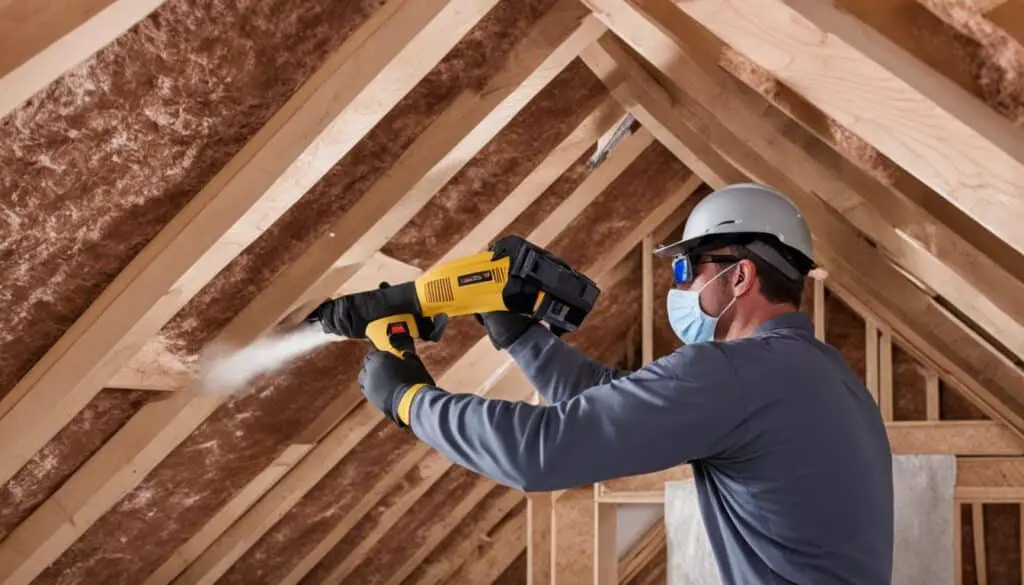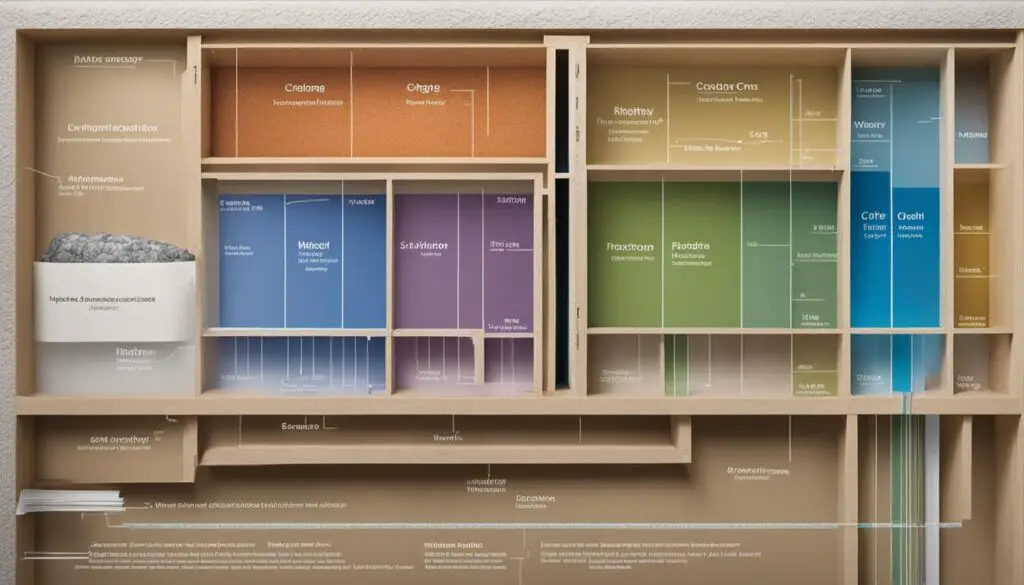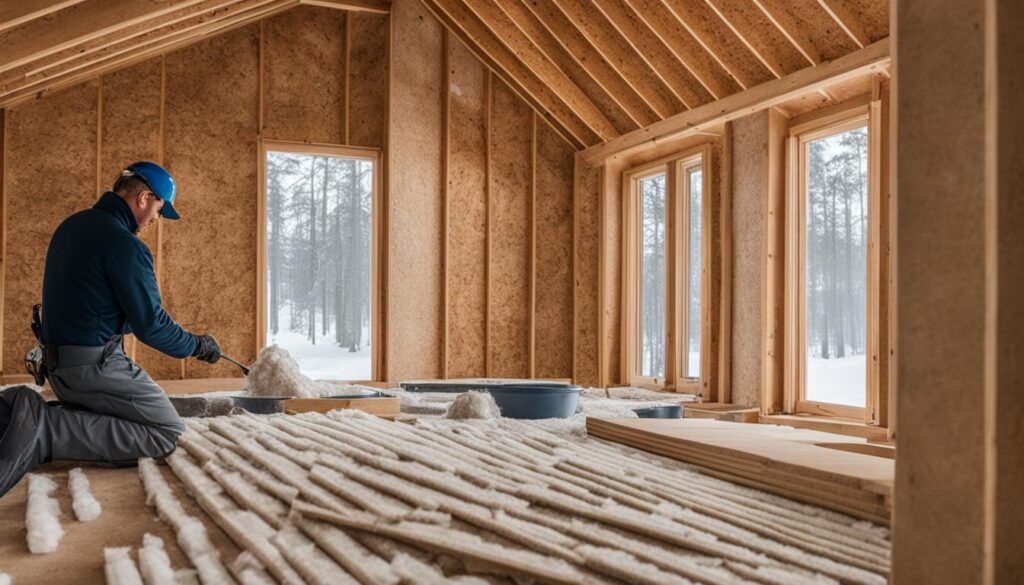When it comes to insulating your home, finding cost-effective methods is key. Not only do you want to maximize comfort and savings, but you also want to ensure that you are optimizing energy efficiency. Luckily, there are several affordable options available that can help you achieve these goals.
By implementing these insulation techniques, you can increase the comfort of your living space while reducing heat loss and saving money on energy bills. From evaluating your home’s insulation needs to sealing air leaks, insulating your attic and walls, and enhancing window insulation, there are various steps you can take to achieve a more energy-efficient home without breaking the bank.
Whether you’re a homeowner looking to improve your living environment or a savvy investor seeking long-term cost savings, cost-effective home insulation methods offer a smart solution. Let’s explore some of the most effective and affordable methods to insulate your home and start maximizing comfort and savings.
Table of Contents
Key Takeaways:
- Implementing cost-effective home insulation methods can maximize comfort and savings.
- Evaluating your home’s insulation needs is crucial before selecting any insulation method.
- Sealing air leaks is an effective and affordable solution to prevent heat transfer.
- Insulating your attic and walls can significantly improve energy efficiency.
- Window insulation options can maximize thermal efficiency and reduce energy consumption.
Evaluating Insulation Needs: Assessing Your Home’s Requirements
Before selecting any insulation method, it is crucial to evaluate your home’s insulation needs. Factors such as climate, type of building, and existing insulation should be considered. Conducting a thorough assessment will help you determine the insulation requirements for different areas of your home, allowing you to make informed decisions about the most cost-effective methods to implement.
When assessing your home’s insulation needs, consider the following:
- Climate: The climate in which you live plays a significant role in determining the insulation requirements. Cold climates require more insulation to prevent heat loss, while hot climates focus on reducing heat gain.
- Type of Building: The type of building you have, such as a single-family home, a multi-story building, or an apartment, will influence the insulation needs. Different building structures may require different insulation materials or techniques.
- Existing Insulation: Evaluate the current state of your home’s insulation. Determine if there are any areas with inadequate insulation or if the existing insulation needs to be upgraded. This information will help you prioritize the areas that require immediate attention.
By carefully evaluating your home’s insulation needs, you can ensure that your insulation efforts are focused on the right areas, maximizing energy efficiency and cost savings. It’s essential to consult with a professional if you’re unsure about any aspects of the evaluation process.
| Factor | Consideration |
|---|---|
| Climate | Determine insulation requirements based on the specific climate you live in. |
| Type of Building | Consider the type of building and its unique insulation needs. |
| Existing Insulation | Evaluate the current insulation and identify areas that require improvement or upgrade. |
Quote:
“By assessing your home’s insulation needs, you can make informed decisions about the most cost-effective methods to implement, ensuring maximum energy efficiency and comfort in your living space.” – Insulation Expert
Seal Air Leaks: An Effective and Affordable Solution
Air leaks are a common cause of energy loss in homes, resulting in increased heating and cooling costs. Fortunately, sealing air leaks is a cost-effective solution that can significantly reduce heat transfer and help you save on energy expenses. By addressing air leaks, you can improve the overall energy efficiency of your home while maximizing comfort.
Common areas where air leaks occur include windows, doors, and electrical outlets. These areas are prone to drafts and can contribute to energy waste. To effectively seal air leaks, consider the following methods:
- Weatherstripping: Weatherstrips are materials that fill gaps and create a tight seal around windows and doors. They help prevent drafts and minimize air leakage. Weatherstripping is easy to install and cost-effective, making it an ideal solution for sealing air leaks.
- Caulking: Caulk is a sealant used to fill gaps and cracks around windows, baseboards, and other areas where air leaks occur. Applying caulk can effectively seal these gaps, preventing drafts and reducing heat loss. It is an affordable and accessible solution that provides long-lasting results.
- Door Sweeps: Installing door sweeps at the bottom of exterior doors can effectively block air leaks and prevent drafts. Door sweeps create a seal between the door and the threshold, minimizing air infiltration. These inexpensive additions can significantly improve the energy efficiency of your home.
By implementing these cost-effective air sealing methods, you can enhance the energy efficiency of your home and reduce both heating and cooling expenses. Sealing air leaks not only helps in draft prevention but also contributes to a more comfortable indoor environment.
Key Takeaways:
Air leak sealing is a cost-effective solution to improve the energy efficiency of your home.
Common areas where air leaks occur include windows, doors, and electrical outlets.
Weatherstripping, caulking, and door sweeps are effective and affordable methods to seal air leaks.
By sealing air leaks, you can reduce heat transfer, prevent drafts, and save on energy costs.
Insulate Your Attic: An Investment That Pays Off
Insulating your attic is a crucial step in improving the energy efficiency of your home. Not only is attic insulation one of the most cost-effective methods, but it also comes with numerous benefits. According to experts, the U.S. Department of Energy recommends a minimum of 12-15 inches of insulation in the attic to effectively prevent heat loss and reduce energy consumption.
By adding insulation to your attic, you create a thermal barrier that helps to keep the desired temperature inside your home. This translates to long-term cost savings as your heating and cooling systems won’t have to work as hard to maintain a comfortable indoor environment. Additionally, adequate insulation in your attic can enhance the overall comfort of your living space by reducing drafts and temperature fluctuations.
One of the key advantages of attic insulation is that it allows you to optimize your HVAC system’s efficiency. Proper insulation reduces the strain on your heating and cooling equipment, allowing them to operate more efficiently and effectively. This not only extends the lifespan of your HVAC system but can also help lower your energy bills.
Furthermore, insulating your attic can improve indoor air quality by preventing the infiltration of outdoor pollutants and allergens. An airtight attic reduces the entry of dust, pollen, and other contaminants, helping to create a healthier environment for you and your family.
To ensure you achieve the maximum benefits of attic insulation, it’s important to use proper installation techniques and choose the most cost-effective materials for your specific needs. Consulting with a professional insulation contractor can help you determine the best insulation method and R-value (a measure of insulation’s resistance to heat flow) for your attic, ensuring optimal energy efficiency.
“Insulating your attic is a wise investment that pays off in terms of energy savings, increased comfort, and improved indoor air quality.”
Attic Insulation Benefits
| Benefits | Description |
|---|---|
| Energy Savings | Reduces heat loss, minimizing the workload on your heating and cooling systems. |
| Cost Savings | Lowers energy bills and increases the lifespan of your HVAC equipment. |
| Enhanced Comfort | Reduces drafts and maintains a more consistent indoor temperature. |
| Improved Indoor Air Quality | Prevents the infiltration of outdoor pollutants and allergens. |
Investing in attic insulation is not only a smart financial decision but also a sustainable choice that benefits both your home and the environment. By reducing energy consumption and improving energy efficiency, you contribute to a greener future while enjoying the immediate advantages of a more comfortable living space.

Wall Insulation: Enhancing Energy Efficiency
Insulating your walls is a crucial step in improving the energy efficiency of your home and reducing heat transfer. By investing in proper wall insulation, you can enjoy a more comfortable living space while also saving on energy costs.
There are various cost-effective methods to insulate exterior walls, each offering its own benefits and considerations. Some popular options include:
- Blown-in insulation: This method involves using loose insulation material, such as fiberglass or cellulose, which is blow into the wall cavities. It is a versatile and effective insulation technique that can fill small gaps and irregularly shaped areas.
- Spray foam insulation: Spray foam insulation is applied as a liquid that expands and hardens, creating an airtight seal. It provides excellent thermal resistance and helps to prevent air leakage, making it a highly efficient option.
- Rigid foam insulation: Rigid foam boards are made from compressed foam materials and can be installed on both interior and exterior walls. This insulation method offers high thermal resistance and is particularly effective in resisting moisture and preventing mold growth.
When deciding on a wall insulation method, it is important to consider the specific needs and characteristics of your home. Factors such as climate, the age of the building, and your budget should all be taken into account. Consulting with a professional insulation contractor can help you determine the most suitable method for your home’s walls and ensure a proper installation.

Enhancing Energy Efficiency Through Wall Insulation
Wall insulation plays a significant role in improving energy efficiency by reducing heat loss and lowering the need for heating and cooling. Properly insulated walls can:
- Minimize heat transfer: Insulation creates a barrier that prevents heat from escaping during cold weather and entering during hot weather. This helps maintain a comfortable indoor temperature, reducing reliance on heating and cooling systems.
- Reduce energy consumption: By minimizing heat loss and gain, wall insulation helps to reduce the energy required to heat and cool your home. This translates to lower energy bills and greater energy savings over time.
- Enhance indoor comfort: Insulated walls can create a more consistent and comfortable indoor environment by reducing drafts and cold spots. This ensures a more pleasant living space throughout the year.
- Improve soundproofing: Along with thermal benefits, wall insulation can also help reduce noise transmission. This is particularly beneficial if you live in a noisy neighborhood or have rooms that require sound isolation.
Investing in affordable wall insulation not only enhances the energy efficiency of your home but also improves overall comfort and reduces environmental impact. By choosing the right insulation method and consulting with professionals, you can make a long-lasting and cost-effective improvement to your home’s insulation system.
Next, let’s explore another crucial aspect of home insulation: window insulation. Continue reading to discover effective strategies for maximizing thermal efficiency through window insulation.
Window Insulation: Maximizing Thermal Efficiency
When it comes to maintaining a comfortable and energy-efficient home, windows play a crucial role. Inadequately insulated windows can contribute to significant heat loss, resulting in higher energy consumption and increased utility bills. To combat this issue, there are two main approaches: upgrading to energy-efficient windows or implementing cost-effective window insulation methods.
Upgrading to energy-efficient windows is a long-term investment that can pay off in terms of both comfort and savings. These windows are designed with advanced technologies that minimize heat transfer, keeping your home cooler in the summer and warmer in the winter. They are typically constructed with multiple panes of glass, gas fills, and low-emissivity coatings that help to reduce heat loss and maintain a consistent indoor temperature. By upgrading to energy-efficient windows, you can maximize thermal efficiency and reduce your household’s energy consumption.
However, if upgrading your windows is not currently feasible due to budget constraints, there are cost-effective insulation methods that can still significantly improve thermal efficiency. One such method is insulating window films. These films are applied directly to the glass surface and provide a layer of insulation that reduces heat transfer. They are transparent and do not obstruct the view, making them a popular choice for homeowners looking to enhance window insulation without compromising aesthetics. Insulating window films are a cost-effective solution that can help retain heat during colder months and reduce the strain on your heating system.
Another cost-effective window insulation method is weatherstripping. Weatherstripping involves sealing any gaps or cracks around the window frames to prevent drafts and air leakage. Common materials used for weatherstripping include adhesive-backed foam tape, V-strip, and door sweeps. By properly sealing these areas, you can minimize heat loss and improve the overall energy efficiency of your windows. Weatherstripping is an affordable and easy-to-install solution that can make a noticeable difference in reducing energy consumption.
In addition to window films and weatherstripping, thermal curtains offer another effective and cost-effective way to insulate your windows. These curtains feature a layer of insulating material that helps to block out drafts and retain heat. Thermal curtains are available in various styles and designs, allowing you to choose options that complement your home decor while providing the desired level of insulation. By using thermal curtains, you can create an additional barrier against heat loss, adding to the overall thermal efficiency of your windows.
Implementing cost-effective window insulation methods not only helps to maximize thermal efficiency but also contributes to a more sustainable and energy-conscious lifestyle. By reducing heat loss, you can decrease your reliance on heating systems, decrease your carbon footprint, and contribute to a greener environment. Whether you opt for energy-efficient windows or cost-effective insulation methods, choosing to invest in window insulation is a smart decision that can lead to long-term comfort, energy savings, and environmental benefits.
Benefits of Window Insulation:
- Maximizes thermal efficiency
- Reduces heat loss
- Lowers energy consumption
- Increases comfort
- Improves overall energy efficiency
- Cost-effective alternatives to upgrading windows
- Contributes to a more sustainable lifestyle
Conclusion
In conclusion, implementing cost-effective home insulation methods is a smart investment that can enhance energy efficiency, maximize comfort, and save you money in the long run. By evaluating your home’s insulation needs, sealing air leaks, insulating your attic and walls, and enhancing window insulation, you can achieve a more comfortable living space while reducing energy consumption.
Start by conducting a comprehensive evaluation of your home’s insulation requirements, taking into account factors such as climate and existing insulation. This assessment will guide you in selecting the most suitable and cost-effective insulation methods for different areas of your home.
Sealing air leaks is an affordable and effective solution to prevent heat loss and optimize energy efficiency. Focus on areas like windows, doors, and electrical outlets, using weatherstripping, caulking, and door sweeps.
Don’t overlook the importance of insulating your attic and walls. Proper insulation in the attic, following the recommended guidelines, can significantly reduce energy consumption and provide long-term cost savings. Likewise, insulating your exterior walls with blown-in insulation, spray foam, or rigid foam insulation can enhance energy efficiency and maximize comfort.
Lastly, window insulation plays a crucial role in maximizing thermal efficiency. Upgrade to energy-efficient windows or utilize cost-effective methods such as insulating window films, weatherstripping, and thermal curtains. These interventions will help retain heat during colder months and reduce energy consumption. Remember to prioritize materials and methods that align with your budget, and consider seeking professional advice to ensure optimal results.
FAQ
What are some cost-effective home insulation methods?
Some cost-effective home insulation methods include sealing air leaks, insulating the attic, insulating the walls, and improving window insulation.
How do I evaluate my home’s insulation needs?
To evaluate your home’s insulation needs, consider factors such as climate, type of building, and existing insulation. Conduct a thorough assessment to determine the insulation requirements for different areas of your home.
How can I seal air leaks in my home?
You can seal air leaks in your home by using weatherstripping, caulking, and adding door sweeps. These affordable methods effectively seal air leaks around windows, doors, and electrical outlets.
Why is insulating the attic important?
Insulating the attic is important because it prevents heat loss and reduces energy consumption. Adding at least 12-15 inches of insulation in the attic can result in long-term cost savings and increased comfort.
What are some methods to insulate exterior walls?
Some cost-effective methods to insulate exterior walls include blown-in insulation, spray foam insulation, and rigid foam insulation. Consulting with a professional can help determine the most suitable method for your home’s walls and budget.
How can I maximize thermal efficiency with window insulation?
You can maximize thermal efficiency with window insulation by upgrading to energy-efficient windows or utilizing cost-effective options. Insulating window films, weatherstripping, and thermal curtains are affordable methods to retain heat and reduce energy consumption.
What are the benefits of cost-effective home insulation?
Cost-effective home insulation enhances energy efficiency, maximizes comfort, and saves money in the long run. By evaluating insulation needs, sealing air leaks, insulating the attic and walls, and improving window insulation, you can achieve a more comfortable living space while reducing energy consumption.


